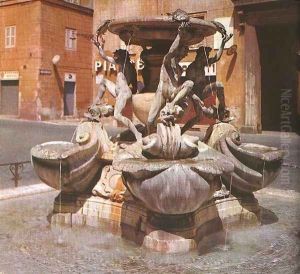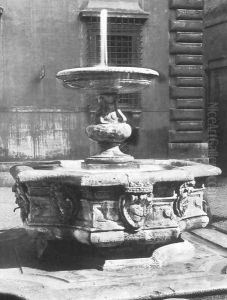Giacomo della Porta Paintings
Giacomo della Porta was an Italian architect and sculptor, who played a significant role in the development of Roman and Italian architecture during the late Renaissance. Born in 1532 in Porlezza, Lombardy, then part of the Duchy of Milan, della Porta was deeply influenced by the monumental works of Michelangelo and was a contemporary of other architects of the Renaissance and Mannerist periods, such as Giacomo Barozzi da Vignola.
Della Porta's career was marked by his collaboration with Michelangelo on the final phase of the construction of St. Peter's Basilica in Vatican City. After Michelangelo's death in 1564, della Porta was appointed as one of the architects to continue the work on St. Peter’s, significantly contributing to the development of the iconic dome. His modifications to Michelangelo's initial plans resulted in a more dynamic and visually coherent dome, which has since become one of the most emblematic features of Renaissance architecture.
Aside from his work on St. Peter’s Basilica, della Porta made significant contributions to the architectural landscape of Rome and other Italian cities. Among his notable projects are the design of the Church of the Gesù, which became the model for Jesuit churches all over the world, demonstrating his mastery of the Baroque style that was emerging during his lifetime. He also worked on the façade of the Church of Santa Maria ai Monti, the design of Villa Aldobrandini in Frascati, and the completion of the Farnese Palace in Rome.
Giacomo della Porta's influence extended beyond his architectural works. He was also involved in urban planning, contributing to the design of several public fountains in Rome, including the famous Fontana del Moro in Piazza Navona. His ability to blend the grandeur of Renaissance architecture with the dynamic complexity of the Baroque style marked him as a pivotal figure in the transition between these two important periods in the history of art.
Della Porta died in Rome in 1602, leaving behind a legacy that had a lasting impact on the development of Western architecture. His works continue to be studied and admired for their artistic and engineering feats, reflecting the innovative spirit of the Renaissance and the early Baroque era.

